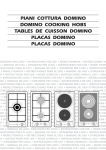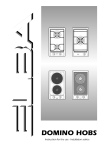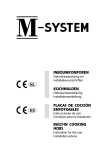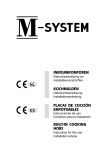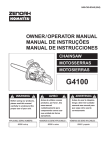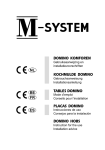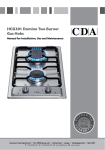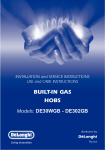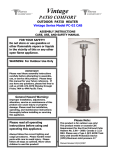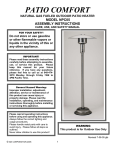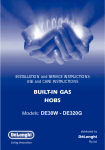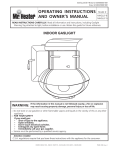Download Caple C762GSS Technical information
Transcript
PIANI COTTURA DA INCASSO IT BUILT-IN COOKING HOBS GB TABLES DE CUISSON ENCASTRABLES FR BE PLACAS DE COCCIÓN EMPOTRABLES ES FOGÃO POR ENCAIXE PT INBOUWKOMFOREN BE NL TRUZIONI PER L’USO • INSTRUCTIONS FOR USE • MODE D’EMPLOI • INSTRUCCIONES PA • MANUAL DE USO • ISTRUZIONI PER L’USO • INSTRUCTIONS FOR USE • MODE D’EMP RUCCIONES PARA EL USO • MANUAL DE USO • ISTRUZIONI PER L’USO • INSTRUCTIONS • MODE D’EMPLOI • INSTRUCCIONES PARA EL USO • MANUAL DE USO • ISTRUZIONI P O • INSTRUCTIONS FOR USE • MODE D’EMPLOI • INSTRUCCIONES PARA EL USO • MAN • ISTRUZIONI PER L’USO • INSTRUCTIONS FOR USE • MODE D’EMPLOI • INSTRUCCIONE SO • MANUAL DE USO • ISTRUZIONI PER L’USO • INSTRUCTIONS FOR USE • MODE D’E RUCCIONES PARA EL USO • MANUAL DE USO • ISTRUZIONI PER L’USO • INSTRUCTIONS • MODE D’EMPLOI • INSTRUCCIONES PARA EL USO • MANUAL DE USO• ISTRUZIONI PE STRUCTIONS FOR USE • MODE D’EMPLOI • INSTRUCCIONES PARA EL USO • MANUAL D UZIONI PER L’USO • INSTRUCTIONS FOR USE • MODE D’EMPLOI • INSTRUCCIONES PARA • MANUAL DE USO • ISTRUZIONI PER L’USO • INSTRUCTIONS FOR USE • MODE D’EMP RUCCIONES PARA EL USO • MANUAL DE USO • ISTRUZIONI PER L’USO • INSTRUCTIONS • MODE D’EMPLOI • INSTRUCCIONES PARA EL USO • MANUAL DE USO • ISTRUZIONI P O • INSTRUCTIONS FOR USE • MODE D’EMPLOI • INSTRUCCIONES PARA EL USO • MAN • ISTRUZIONI PER L’USO • INSTRUCTIONS FOR USE • MODE D’EMPLOI • INSTRUCCION SO • MANUAL DE USO• ISTRUZIONI PER L’USO • INSTRUCTIONS FOR USE • MODE D’EM RUCCIONES PARA EL USO • MANUAL DE USO • ISTRUZIONI PER L’USO • INSTRUCTIONS • MODE D’EMPLOI • INSTRUCCIONES PARA EL USO • MANUAL DE USO • ISTRUZIONI P O • INSTRUCTIONS FOR USE • MODE D’EMPLOI • INSTRUCCIONES PARA EL USO • MAN • ISTRUZIONI PER L’USO • INSTRUCTIONS FOR USE • MODE D’EMPLOI • INSTRUCCIONE SO • MANUAL DE USO• ISTRUZIONI PER L’USO • INSTRUCTIONS FOR USE • MODE D’EM RUCCIONES PARA EL USO • MANUAL DE USO • ISTRUZIONI PER L’USO • INSTRUCTIONS • MODE D’EMPLOI • INSTRUCCIONES PARA EL USO • MANUAL DE USO • ISTRUZIONI P O • INSTRUCTIONS FOR USE • MODE D’EMPLOI • INSTRUCCIONES PARA EL USO • MAN • ISTRUZIONI PER L’USO • INSTRUCTIONS FOR USE • MODE D’EMPLOI • INSTRUCCION SO • MANUAL DE USO • ISTRUZIONI PER L’USO • INSTRUCTIONS FOR USE • MODE D’E RUCCIONES PARA EL USO • MANUAL DE USO• ISTRUZIONI PER L’USO • INSTRUCTIONS 6 5 4 0 3 1 2 P60 P90 6 5 4 0 3 1 2 ITALIANO Istruzioni per l’uso Pagina 3 La Casa Costruttrice non risponde delle possibili inesattezze, imputabili ad errori di stampa o trascrizione, contenute nel presente libretto. Si riserva il diritto, pregiudicare le caratteristiche essenziali di funzionalità e sicurezza, di apportare ai propri prodotti, in qualunque momento e senza preavviso, le eventuali modifiche opportune per qualsiasi esigenza di carattere costruttivo o commerciale. ENGLISH Instructions for use Page 19 The manufacturer cannot be held responsible for possible inaccuracies due to printing or transcription errors in the present booklet. The manufacturer reserves the right to make all modifications to its products deemed necessary for manufacture or commercial reasons at any moment and without prior notice, without jeopardising the essential functional and safety characteristics of the appliances. FRANÇAIS Note d’emploi Page 33 Le fabricant n’est pas responsable des erreurs éventuelles, dues à des fautes de frappe ou d’impression, susceptibles de se trouver dans cette notice. Il se réserve le droit, sans porter préjudice aux caractéristiques essentielles, du point de vue fonctionnel et du point de vue sécurité, d’apporter à ses produits, à tout moment et sans préavis, toutes les modifications éventuellement nécessaires pour faire face à des exigences de fabrication ou de commercialisation. ESPAÑOL Instrucciones para el uso Página 47 La casa constructora no responde por los posiles errores de impresion o de transcripción, contenidos en el presente manual. Se reserva el derecho, sin comprometer las características esenciales de funcionalidad y seguridad, de aportar a sus propios prodúctos, en cualquier momento y sin preaviso, eventuales modificaciones oportunas para cualquier exigencia de carácter constructivo o comercial. PORTUGUÊS Instrucoes para o uso Página 61 O fabbricante não reponde pelas possiveis inesatesas, imputabilidades e erros de impressão ou transcrições contidas no presente manual. Se reserva o direito, sem prejudicar a característica essencial de funcionalidade e segurança, de produzir nos proprios produtos em qualquer momento e sem aviso previo, eventuais modificações oportunas para as exigências de caracter construtivo ou comercial. NEDERLAND 2 Gebruiksaanwijzing Bladzijde 75 De fabrikant kan niet aansprakelijk gesteld worden voor onwaarheden in deze folder veroorzaakt door druk- of vertaalfouten. De fabrikant heeft het recht alle wijzigingen aan het produkt aan te brengen die zij voor commerciële- of fabricagedoeleinden noodzakelijk acht, op ieder moment en zonder voorafgaande kennisgeving. ENGLISH Instructions for use Dear Customer, Thank you for having purchased and given your preference to our product. The safety precautions and recommendations reported below are for your own safety and that of others. They will also provide a means by which to make full use of the features offered by your appliance. Please preserve this booklet carefully. It may be useful in future, either to yourself or to others in the event that doubts should arise relating to its operation. This appliance must be used only for the task it has explicitly been designed for, that is for cooking foodstuffs. Any other form of usage is to be considered as inappropriate and therefore dangerous. The manufacturer declines all responsibility in the event of damage caused by improper, incorrect or illogical use of the appliance. IMPORTANT PRECAUTIONS AND RECOMMENDATIONS ✓ After having unpacked the appliance, check to ensure that it is not damaged. If you have any doubts, do not use it and consult your supplier or a professionally qualified technician. ✓ Packing elements (i.e. plastic bags, polystyrene foam, nails, packing straps, etc.) should not be left around within easy reach of children, as these may cause serious injuries. ✓ The packaging material is recyclable and is marked with the recycling symbol . ✓ Do not attempt to modify the technical characteristics of the appliance as this may become dangerous to use. ✓ The manufacturer cannot be considered responsible for damage caused by unreasonable, incorrect or rash use of the appliance. ✓ If you should decide not to use this appliance any longer (or decide to substitute an older model), before disposing of it, it is recommended that it be made inoperative in an appropriate manner in accordance to health and environmental protection regulations, ensuring in particular that all potentially hazardous parts be made harmless, especially in relation to children who could play with old appliances. ✓ The appliance should be installed and all the gas/electrical connections made by a qualified engineer in compliance with local regulations in force and following the manufacturer's instructions TIPS FOR THE USER ✓ During and after use of the cooktop, certain parts will become very hot. Do not touch hot parts. ✓ Keep children away from the cooking hob when it is in use. ✓ After use, ensure that the knobs are in position ● (off), and close the main gas delivery valve or the gas cylinder valve. ✓ In case of difficulty in the gas taps operation, call Service. ✓ Before any cleaning or maintenance, switch off the electricity to the cooktop. Risk of fire! ✓ Do not leave inflammable material on the cooktop. ✓ Make sure that the electrical cables of other appliances installed nearby cannot come into contact with the cooktop. ✓ Never cook the food directly on the electric hotplates, but in special pans or containers. IMPORTANT PRECAUTIONS AND RECOMMENDATIONS FOR USE OF ELECTRICAL APPLIANCES Use of any electrical appliance implies the necessity to follow a series of fundamental rules. In particular: ✓ Never touch the appliance with wet hands or feet; ✓ do not operate the appliance barefooted; ✓ do not allow children or disabled people to use the appliance without your supervision. The manufacturer cannot be held responsible for any damages caused by improper, incorrect or unreasonable use of the appliance. DECLARATION OF CE CONFORMITY – This cooking hob has been designed to be used only for cooking. Any other use (such as heating a room) is improper and dangerous. – This cooking hob has been designed, constructed, and marketed in compliance with: - Safety requirements of the "Gas" Directive 90/396/EEC; - Safety requirements of EEC Directive “Low voltage” 73/23 (gas or gas/electric appliances); - Safety requirements of EEC Directive “EMC” 89/336 (gas or gas/electric appliances); - Requirements of EEC Directive 93/68. These instructions are only valid for the countries indicated by the symbols on the cover of the instruction booklet and on the appliance itself. 19 1 FEATURES 14 20 12 19 10 18 22 22 Fig. 1.1a Fig. 1.2a 14 14 13 13 12 10 10 22 22 Fig. 1.1b 12 Fig. 1.2b 14 14 13 11 13 11 22 10 22 Fig. 1.1c 12 10 Fig. 1.2c 21 14 14 13 12 10 6 4 0 3 1 20 15 5 17 12 22 10 22 2 Fig. 1.1d Fig. 1.2d The appliance has class 3 14 11 13 12 16 NOTE: ✓ If the appliance has a safety valve system fitted (beside every burner is a T-shaped probe, as in Fig. 3.1 - not to be confused with the S-shaped electrode of the gas-lighter), the flow of gas will be stopped if and when the flame should accidentally go out. 10 22 Fig. 1.2e COOKING POINTS 6 5 4 0 3 1 21 17 2 14 13 12 10 1. 2. 3. 4. 5. 6. Auxiliary burner (A) Semirapid burner (SR) Rapid burner (R) Triple ring burner (TR) Fish burner (PS) Electric plate - normal (1000 W) - rapid (1500 W) - 1,00 1,75 3,00 3,50 2,95 kW kW kW kW kW 22 Fig. 1.2f DESCRIPTION CONTROL PANEL 10. 11. 12. 13. 14. 15. 16. 17. 18. 19. 20. 21. 22. Auxiliary burner control knob (1) Rapid burner control knob (3) Triple ring burner control knob (4) Left semirapid burner control knob (2) Right semirapid burner control knob (2) Central fish-burner control knob (5) Central auxiliary burner control knob (1) Electrical plate control knob (6) Right triple ring burner control knob (4) Left triple ring burner control knob (4) Central semirapid burner control knob (2) Electrical plate indicator light Electric gas-lighting device; if the device is not installed, the appliance may be provided with: - A gas-lighter incorporated into the knob (★ symbol beside flame - No gas-lighter (no ★ symbol beside knobs). - max. heat/max. gas flow). CAUTION: If the burner is accidentally extinguished, turn the gas off at the control knob and wait at least 1 minute before attempting to relight. CAUTION: Gas hobs produce heat and humidity in the environment in which they are installed. Ensure that the cooking area is well ventilated by opening the natural ventilation grilles or by installing an extractor hood connected to an outlet duct. CAUTION: If the hob is used for a prolonged time it may be necessary to provide further ventilation by opening a window or by increasing the suction power of the extractor hood (if fitted). 21 2 HOW TO USE THE COOKER TOP GAS BURNERS Gas flow to the burners is adjusted by turning the knobs (illustrated in figs. 2.1a 2.1b) which control the safety valves. Turning the knob so that the indicator line points to the symbols printed on the panel achieves the following functions: – full circle ● = closed valve – symbol or = maximum aperture or flow – symbol Fig. 2.1a = minimum aperture or flow ✓ To reduce the gas flow to minimum, rotate the knob further anti-clockwise to point the indicator towards the small flame symbol. ✓ The maximum aperture position permits rapid boiling of liquids, whereas the minimum aperture position allows slower warming of food or maintaining boiling conditions of liquids. ✓ Other intermediate operating adjustments can be achieved by positioning the indicator between the maximum and minimum aperture positions, and never between the maximum aperture and closed positions. N.B. If your local gas supply makes it difficult to light the burner with the knob set to maximum, set the knob to minimum and repeat the operation. LIGHTING GAS BURNERS FITTED WITH SAFETY VALVE DEVICE In order to light the burner, you must: 1 – Turn the knob fig. 2.1b in anti-clockwise direction up to the maximum aperture (symbol ), push in and hold the knob; this will light the gas. In case of black-out, bring a lighted match close to the burner. 2 – Wait about ten seconds after the gaslights before releasing the knob (starting time for the valve). 3 – Adjust the gas valve to the desired position. If the burner flame should go out for some reason, the safety valve will automatically stop the gas flow. To re-light the burner, return the knob to the closed ● position, wait for at least 1 minute and then repeat the lighting procedure. Fig. 2.1b LIGHTING GAS BURNERS Models without electric ignition To light one of the gas burners, hold a flame (e.g. a match) close to the top part of the burner, push in and turn the relative knob in an anti-clockwise direction (fig. 2.3), pointing the knob indicator towards the large flame symbol (i.e. max. gas flow). Models fitted with electric spark lighter button Fig. 2.2 On these cooker tops, to light one of the burners you have to push in and turn the relative knob to the maximum aperture position (large flame symbol ) and press the electric lighter button (fig. 2.2) until the flame has been lit. Adjust the gas valve to the desired position. Models fitted with electric lighter incorporated into the burner knobs The electric ignition is incorporated in the knobs (★ symbol beside flame - max. heat/max. gas flow fig. 2.1b). To light one of the gas burners, push in and turn the relative knob to the maximum aperture position (large flame symbol) and hold the knob in until the flame has been lit. 22 Fig. 2.3 The sparks produced by the lighter situated inside the relative burner will light the flame. Adjust the gas valve to the desired position. N.B. When the cooker top is not being used, set the gas knobs to their closed positions and also close the cock valve on the gas bottle or the main gas supply line. CHOICE OF BURNER (fig. 2.4) The symbols printed on the panel beside the gas knobs indicate the correspondence between the knob and the burner. The most suitable burner is to be chosen according to the diameter and volume capacity of the container to be warmed. It is important that the diameter of the pots or pans suitably match the heating potential of the burners in order not to jeopardise the efficiency of the burners, bringing about a waste of gas fuel. A small diameter pot or pan placed on a large burner does not necessarily mean that boiling conditions are reached quicker. AUXILIARY GRATE FOR SMALL PANS “On request“ (fig. 2.5). This grate is to be placed on top of the (smaller) auxiliary burner when using small diameter pans, in order to prevent them from tipping over. Never cook food directly on the electric hotplates! Always use a saucepan or special container. NORMAL HOTPLATE To turn on the electric hotplate, rotate the knob (fig. 2.7) o the desired setting. The numbers from 1 to 6 indicate the operating positions with increasing number corresponding to higher temperature settings. When the pan comes to the boil, turn the heat down to the level desired. Fig. 2.5 SPECIAL WOK GRILLE” “On request“ (fig. 2.6a e 2.6b) This special grille for woks should be placed over the pan-rest for the triple ring burner. Warning: ✓ Using woks without this special grille may cause the burner to malfunction. ✓ Do not use the grille for ordinary, flatbottomed saucepans. Fig. 2.4 ELECTRIC HOTPLATES RAPID HOTPLATE (red dot) The rapid hotplate control knob is similar to that of the normal hotplate, with 6 selectable heating positions (fig. 3.1). The characteristics of this hotplate, which is also equipped with a thermostatic cutoff device, make it possible to: ✓ achieve the cooking temperature rapidly ✓ make full use of its output power using flat-bottomed pans ✓ limit the output power with unsuitable saucepans. DIAMETERS OF PANS WHICH MAY BE USED ON THE HOBS BURNERS MINIMUM MAX. * Auxiliary 12 cm 14 cm Semirapid 16 cm 24 cm Rapid 24 cm 26 cm Triple-ring 26 cm 28 cm 6 5 4 WRONG 0 Fish burner from 12x30 to 18x40 cm 3 Maximum diameter for woks: 36 cm 1 * with grill for small cookware: minimum diameter: 6 cm 2 Fig. 2.7 do not use pans with concave or convex bases Fig. 2.6a CORRECT Caution! the cooking hob becomes very hot during operation. Keep children well out of reach. Fig. 2.6b 23 PROPER USE OF THE ELECTRIC HOTPLATE (fig. 2.8) When the pan comes to the boil, turn the heat down to the level desired. Remember that the hotplate will continue to produce heat for about five minutes after it has been turned off. While using the electric hotplate, you must: ✓ avoid keeping it on without something on it; ✓ avoid pouring liquids on it while it is hot; ✓ use flat-bottomed (electric hotplate type) pots and pans only ✓ use cooking receptacles which cover as much of the surface of the hotplate as possible. ✓ to save electricity, use lids whenever possible. ✓ never cook food directly on the hotplate: always use a pan or suitable container. An indicator light located on the control panel signals that the hotplate is operating. ELECTRIC HOTPLATE USAGE TABLE Hob controlled by 7-position switch 0-6 Position of switch 1 0 Switched OFF 1 2 For melting operations (butter, chocolate). 2 To maintain food hot and to heat small quantities of liquid (sauces, eggs). 3 To heat bigger quantities; to whip creams and sauces. (vegetables, fruits, soups). 3 4 Slow boiling, i.e.: meats, spaghetti, continuations of cooking of roasts, potatoes. 4 For every kind of frying, cutlets, uncovered cooking, i.e.: risotto. 4 5 Browning of meats, roasted potatoes, fried fish, omelettes, and for boiling large quantities of water. 6 Fast frying, grilled steaks, etc. 2 3 4 5 6 = Warming = Cooking = Roasting - Frying Fig. 2.9 Fig. 2.8 24 TYPE OF COOKING Caution! the cooking hob becomes very hot during operation. Keep children well out of reach. boiled soups, steam, stews, 3 CLEANING AND MAINTENANCE GENERAL ADVICE GLASS LID (optional) ✓ Before you begin cleaning you must ensure that the hob is switched off. ✓ It is advisable to clean when the appliance is cold and especially when cleaning the enamelled parts. ✓ All enamelled surfaces have to be washed with soapy water or some other non-abrasive product with a sponge and are to be dried preferably with a soft cloth. ✓ Avoid leaving alkaline or acid substances (lemon juice, vinegar etc.) on the surfaces. ✓ Do not close the glass lid when the electrical plates are still hot and when the oven, installed below the cooking hob is on or still hot. ✓ Do not rest hot pans or heavy objects on the cooker lid. ✓ Remove any spillages from the surface of the lid before opening. CLEANING ELECTRIC HOTPLATES ENAMELLED PARTS ✓ All the enamelled parts must be cleaned with a sponge and soapy water only or other non-abrasive products. ✓ Dry preferably with a chamois leather. If acid substances such as lemon juice, tomato conserve, vinegar etc. are left on the enamel for a long time they will etch it, making it opaque. ✓ Always clean when the hotplate is tepid. ✓ Use a soft cloth, dampened with water, and a little salt. To finish off, use a soft cloth with a little oil. ✓ Do not use water, to avoid the formation of rust. BURNERS AND GRIDS STAINLESS STEEL ELEMENTS ✓ Stainless steel parts must be rinsed with water and dried with a soft and clean cloth or with a chamois leather. ✓ For persistent dirt, use specific non-abrasive products available commercially or a little hot vinegar. ✓ Note: regular use could cause discolouring around the burners, because of the high flame temperature. CONTROL KNOB ✓ The control knobs may be removed for cleaning but care should be taken not to damage the seal. ✓ These parts can be removed and cleaned with appropriate products. ✓ After cleaning, the burners and their flame spreaders must be well dried and correctly replaced. ✓ It is very important to check that the burner flame spreader and the cap have been correctly positioned. Failure to do so can cause serious problems. ✓ In the models with safety device, check that the probe next to each burner is always clean to ensure correct operation of the safety valves. ✓ In appliances with electric ignition keep the electrode clean so that the sparks always strike. ✓ Note: To avoid damage to the electric ignition do not use it when the burners are not in place. GAS TAPS ✓ Periodic lubrication of the gas taps must be carried out by specialist personnel only. ✓ In the event of operating faults in the gas taps, call the Service Department. Do not use steam jet cleaners because the humidity could infiltrate into the appliance making it dangerous. 25 CORRECT REPLACEMENT OF THE BURNERS It is very important to check that the burner flame spreader “F” and the cap “C” have been correctly positioned (see figs. 3.1 and 3.2 ). Failure to do so can cause serious problems. In appliances with electric ignition, check that the electrode “S” (fig. 3.1) is always clean to ensure trouble-free sparking. C F In the models with safety device, check that the probe “T” (fig. 3.1) next to each burner is always clean to ensure correct operation of the safety valves. Both the probe and ignition plug must be very carefully cleaned. T S Fig. 3.1 Fig. 3.2 CORRECT POSITION OF TRIPLE RING BURNER The triple ring burner must be correctly positioned (see fig. 3.3); the burner rib must be fitted in their housing as shown by the arrow. The burner correctly positioned must not rotate (fig. 3.4). Then position the cap A and the ring B (fig. 3.4 - 3.5). Fig. 3.3 A B Fig. 3.4 CORRECT POSITION OF THE FISH BURNER This burner must be correctly positioned as shown in the figure 3.6. Fig. 3.6 26 Fig. 3.5 Installation advice 4 INSTALLATION IMPORTANT ✓ The appliance should be installed, regulated and adapted to function with other types of gas by a QUALIFIED INSTALLATION TECHNICIAN. Failure to comply with this condition will render the guarantee invalid. ✓ The appliance must be installed in compliance with regulations in force. ✓ Installation technicians must comply to current laws in force concerning ventilation and the evacuation of exhaust gases. ✓ Always unplug the appliance before carrying out any maintenance operations or repairs. ✓ The appliance must be housed in heat-resistant units. ✓ These tops are designed to be embedded into kitchen fixtures measuring 600 mm in depth. ✓ The walls of the units must not be higher than work top and must be capable of resisting temperatures of 105 °C above room temperature. ✓ Do not instal the appliance near inflammable materials (eg. curtains). TECHNICAL INFORMATION FOR THE INSTALLER In order to install the cooker top into the kitchen fixture, a hole with the dimensions shown in fig. 4.1 (for cooker top P90) o 4.2 (for cooker top P60) has to be made, bearing in mind the following: 500 ✓ within the fixture, between the bottom side of the cooker top and the upper surface of any other appliance or internal shelf there must be a clearance of at least 30 mm; ✓ the cooker top must be kept no less than 200 mm away from any side wall (figs. 4.1 - 4.2). 200 860 60 min 840 0 48 0 –2 min 0 –2 Fig. 4.1 ✓ the hob must be installed at least 60 mm from the wall. ✓ there must be a distance of at least 650 mm between the hob and any wall cupboard or extractor hood positioned immediately above (see figs. 4.3-4.4). 500 580 ✓ It is absolutely essential that you place a separator between the base of the hob and the drawer unit. 60 ✓ if the hob is installed over a built-in oven, there must be a distance of at least 30 mm between the two appliances. The two appliances should be connected to the gas supply with independent connections. 200 0 48 560 0 –2 0 –2 Fig. 4.2 27 The room where the gas appliance is to be installed must have a natural flow of air so that the gas can burn (in compliance with the current laws in force). The flow of air must come directly from one or more openings made in the outside walls with a free area of at least 100 cm2. If the appliance does not have a noflame safety device this opening must have an area of at least 200 cm2. The openings should be near the floor and preferably on the side opposite the exhaust for combustion products and must be so made that they cannot be blocked from either the outside or the outside. When these openings cannot be made, the necessary air can come from an adjacent room which is ventilated as required, as long as it is not a bedroom or a danger area (in compliance with the current laws in force). In this case, the kitchen door must allow the passage of the air. in mm 60 m 500 mm 200 mm min 450 mm 650 mm Fig. 4.3 m 60 m DISCHARGING PRODUCTS OF COMBUSTION min Extractor hoods connected directly to the outside must be provided, to allow the products of combustion of the gas appliance to be discharged (fig. 4.6). If this is not possible, an electric fan may be used, attached to the external wall or the window; the fan should have a capacity to circulate air at an hourly rate of 3-5 times the total volume of the kitchen (fig. 4.7). The fan can only be installed if the room has suitable vents to allow air to enter, as described under the heading “Choosing suitable surroundings”. 500 mm 200 mm min Fig. 4.4 INSTALLATION IN KITCHEN CABINET WITH DOOR (fig. 4.5) It is recommended that a 30 mm clearance be left between the cooker top and the fixture surface (fig. 4.5). 30 mm Fig. 4.5 Clearance Door Space for connections 28 Intensive and prolonged use may require extra ventilation, e.g. opening a window, or more efficient ventilation increasing the mechanical suction power if this is fitted. Extractor hood for products of combustion H min 650 mm 450 mm 650 mm CHOOSING SUITABLE SURROUNDINGS Air vent Fig. 4.6 Electric fan to extract products of combustion Air vent Fig. 4.7 COOKING HOBS - P60 series FASTENING THE INSTALLATION BRACKETS FASTENING THE COOKER TOP (figs. 4.9 and 4.10) ✓ Spread the sealing material “C” out along the fixture hole, making sure that the junctions overlap at the corners. (figs. 4.8, 4.9, 4.10) ✓ Each cooker top is provided with an installation kit including brackets and screws for fastening the top to fixture panels from 2 to 4 cm thick. ✓ Insert the cooker top into the hole and position it correctly. ✓ Turn the cooker top upside down and fasten the brackets “F and R” to the appropriate socket holes, without tightening the screws “B” for the moment. ✓ With a sharp cutter or trimmer knife trim the excess sealing material around the edge of the cooker top. ✓ Adjust the position of the brackets “F and R” and tighten screws “B” to block the cooker top firmly in position. ✓ Make sure that the brackets are fastened as shown in figure 4.8. D Fig. 4.8 C C D R Fig. 4.9 NT FRO R B F F Fig. 4.10 F 40 mm max. B 20 mm min. R COOKING HOBS - P90 series FASTENING THE INSTALLATION BRACKETS (fig. 4.11) FASTENING THE COOKER TOP (fig. 4.12) ✓ Spread the sealing material “C” out along the fixture hole, making sure that the junctions overlap at the corners. ✓ Each cooker top is provided with an installation kit including brackets and screws for fastening the top to fixture panels from 2 to 4 cm thick. ✓ Insert the cooker top into the hole and position it correctly. ✓ Turn the cooker top upside down and fasten the brackets “A” to the appropriate socket holes, without tightening the screws “B” for the moment. ✓ With a sharp cutter or trimmer knife trim the excess sealing material around the edge of the cooker top. ✓ Adjust the position of the brackets “A” and tighten screws “B” to block the cooker top firmly in position. ✓ Make sure that the brackets are fastened as shown in figure 4.11. C A Fig. 4.11 A A A B Fig. 4.12 A 40 mm max. A 20 mm min. A 29 5 GAS SECTION GAS CONNECTIONS Type 1 connection Make sure that the hob is adapted to function with the type of gas supply available (see label). If not, refer to the section headed “Adapting the appliance to function with different types of gas”. C F A GASES The gases used for the operation of cooking appliances may be grouped by their characteristics into two types: ✓ Butane/Propane gas (in cylinders) G30/G31 ✓ Natural gas G20 F G Connecting to gas mains: GB ✓ Cat: 1/2" G conical II 2H3+ Fig. 5.1a Cooktop connection: Type 1 connection (fig. 5.1a) or ✓ nut “A” ✓ cylindrical elbow “C” ✓ conical adaptor “G” ✓ gaskets “F” Type 2 connection (fig. 5.1b) ✓ nut “A” ✓ conical elbow “C” ✓ gasket “F” Type 2 connection C F A Connection to the gas main must be performed by a qualified technician, in compliance with the current laws in force. Type 1 connection: Before connecting the appliance to the gas main, mount conical adaptor “G” (supplied with appliance) onto the elbow “C,” upon which the washer “F” has been placed. 1/2" G conical To maintain the thickness of 3 cm, the hob is fitted with a channel to contain the connection pipe. Fig. 5.1b The gas inlet union can be turned in the direction required after the union elbow “C” - nut “A” connection has been slackened (Fig. 5.2). Never put it in the horizontal or vertical position. IMPORTANT: ✓ Never turn union “C” using force without first slackening nut A. ✓ Gaskets “F” (Fig. 5.1) guarantee the seal of the gas connection. Replace them whenever they are even slightly deformed or imperfect. ✓ Any connection to fixed metal pipes must be done in such a way so as not to place undue stress on the hob chassis. ✓ If using flexible metal pipes, make sure they are not squashed, and do not come into contact with moving parts. ✓ Any flexible pipes must be so installed as to be easily inspected along their whole length. They must be changed before the expiry date (printed on the pipe itself) and not exceed 2 metres in length. ✓ After connecting to the gas mains, check that the couplings are correctly sealed, using soapy solution, but never a naked flame. ADAPTING THE APPLIANCE TO FUNCTION WITH DIFFERENT TYPES OF GAS If a gas different from that indicated on the label is used, adapt the cooktop to this new function. Every cooking hob is provided with a set of injectors for the various types of gas. Injectors not supplied can be obtained from the After-Sales Service. Select the injectors to be replaced according to the TABLE FOR THE CHOICE OF THE INJECTORS. The nozzle diameters, expressed in hundredths of a millimetre, are marked on the body of each injector. 30 Fig. 5.2 TABLE FOR THE CHOICE OF THE INJECTORS Cat: II 2H3+ GB NOMINAL POWER (HS - kW) REDUCED POWER (HS - kW) Ø INJECTOR (1/100 mm) Auxiliary (A) 1,00 0,30 72 (X) Semi-rapid (SR) 1,75 0,45 97 (Z) Gas type: G20 BURNERS Rapid (R) 3,00 0,75 115 (Y) Triple ring (TC) 3,50 1,50 135 (T) Fish burner (PS) 2,95 1,50 120 (F3) NOMINAL POWER (HS - kW) REDUCED POWER (HS - kW) Ø INJECTOR (1/100 mm) Auxiliary (A) 1,00 0,30 50 Semi-rapid (SR) 1,75 0,45 65 Rapid (R) 3,00 0,75 85 Triple ring (TC) 3,50 1,50 95 Fish burner (PS) 2,95 1,50 85 Gas type: G30/G31 BURNERS OPERATIONS TO BE PERFORMED WHEN SUBSTITUTING THE INJECTORS To replace the injectors: ✓ Remove the gratings, the burner covers and the knobs; ✓ Using a wrench substitute the nozzle injectors “J” (Fig. 5.3 - 5.4) with those most suitable for the kind of gas for which it is to be used. The burner are conceived in such a way so as not to require the regulation of the primary air. REGULATING THE BURNER MINIMUM SETTING When changing from one type of gas to another, the minimum tap output must also be correct, considering that in this position the flame must be about 4 mm long and must remain lit even when the GAS PRESSURE (mbar) 20 GAS PRESSURE (mbar) 28-30/37 knob is turned sharply from the maximum to the minimum position. LUBRICATING THE GAS TAPS The adjustment is performed with the burner lit, as follows: – Turn the knob to the minimum position. – Remove the tap knob. If one of the gas taps becomes difficult to turn, dismantle it, thoroughly clean with petrol and apply special high-temperature grease. On gas valves provided with adjustment screw in the centre of the shaft (fig. 5.5): ✓ Using a screwdriver with max. diameter 3 mm, turn the screw inside the tap until the correct setting is obtained. These operations must be performed by a specialised engineer. On gas valves provided with adjustment screw on the valve body (fig. 5.6): ✓ Turn the screw “A” to the correct setting with a screwdriver. ✓ In models with a gas-lighter incorporated into the knob, turn screw “A” via the hole in the microswitch. For G 30/G 31 gas, tighten the adjustment screw completely. Fig. 5.5 J J A Fig. 5.3 Fig. 5.4 Fig. 5.6 31 6 ELECTRICAL SECTION IMPORTANT: Installation has to be carried out according to the instructions provided by the manufacturer. Incorrect installation might cause harm and damage to people, animals or objects, for which the manufacturer accepts no responsibility. DETAILS ✓ Connection to the electric power supply must be carried out by a qualified technician and following the appropriate safety regulations; ✓ Before carrying out the connection to the power supply, the voltage rating of the appliance (stamped on the appliance identification plate) must be checked for correspondence to the available mains supply voltage, and the mains electric wiring should be capable of handling the cooker’s power rating (also indicated on the identification plate); Connection to a good earth wiring system is absolutely essential. The manufacturer accepts no responsibility for any inconvenience caused by failure to comply with this rule. – N.B. For connections to the mains power supply, never use adaptors, reductions or multiple power points as these may overheat and catch fire. In the event that installation should require modifications to the mains supply wiring system, it is recommended that a qualified technician be called to carry out substitution. The technician will also have to verify that the cross-section of the electric cables on the power point match the appliance’s power rating. ✓ If the appliance is supplied without a power supply plug and you are not connecting directly to the mains, a standardized plug suitable for the load must be fitted. ✓ The power point must be connected to a suitable earth wiring, in conformity to current safety regulations. ✓ The colours of the wires in the hob power cable may not correspond with the colours marked on the terminals of your electrical plug. The plug should in any case be wired as follows: – connect the green/yellow wire to the terminal marked with the letter PE or the earth symbol or coloured green/yellow; – connect the blue wire to the terminal marked with the letter N or coloured black; – connect the brown wire to the terminal marked with the letter L or coloured red. FEEDER SPECIAL CABLE SECTION Type “HO5V2V2-F” resistance to temperatures of 90°C 230 VAC 3 x 0,75 mm2 230 VAC 3 x 1 mm2 (for model with a rating of 1,5 kW at 230 V) ✓ It is possible to connect the appliance directly to the mains supply by means of a heavy duty switch with 3 mm minimum distance between the contacts. ✓ The power supply cord must not touch against any hot surfaces and must be placed so that its temperature does not exceed 75°C at any point along its length. ✓ After having installed the appliance, the power switch or power plug must always be in a accessible position. ✓ The supply cable must be replaced with a cable of the same type. ✓ The electrical cable must be connected to the terminal board following the diagrams of fig. 6.1. ✓ The appliance must have its own supply; any other appliances installed near it must be supplied separately. 230 V L1 PE N(L2) Before carrying out any work on the electrical section of the appliance, it must be disconnected from the mains. Fig. 6.1 32 Cod. 1102138 ß4 ISTRUZIONI PER L’USO • INSTRUCTIONS FOR USE • MODE D’EMPLOI • INSTRUCCIONES SO • MANUAL DE USO • ISTRUZIONI PER L’USO • INSTRUCTIONS FOR USE • MODE D’EM STRUCCIONES PARA EL USO • MANUAL DE USO • ISTRUZIONI PER L’USO • INSTRUCTIO SE • MODE D’EMPLOI • INSTRUCCIONES PARA EL USO • MANUAL DE USO • ISTRUZION USO • INSTRUCTIONS FOR USE • MODE D’EMPLOI • INSTRUCCIONES PARA EL USO • MA SO• ISTRUZIONI PER L’USO • INSTRUCTIONS FOR USE • MODE D’EMPLOI • INSTRUCCIO L USO • MANUAL DE USO • ISTRUZIONI PER L’USO • INSTRUCTIONS FOR USE • MODE D STRUCCIONES PARA EL USO • MANUAL DE USO • ISTRUZIONI PER L’USO • INSTRUCTIO SE • MODE D’EMPLOI • INSTRUCCIONES PARA EL USO • MANUAL DE USO• ISTRUZIONI INSTRUCTIONS FOR USE • MODE D’EMPLOI • INSTRUCCIONES PARA EL USO • MANUAL TRUZIONI PER L’USO • INSTRUCTIONS FOR USE • MODE D’EMPLOI • INSTRUCCIONES PA SO • MANUAL DE USO • ISTRUZIONI PER L’USO • INSTRUCTIONS FOR USE • MODE D’EM STRUCCIONES PARA EL USO • MANUAL DE USO • ISTRUZIONI PER L’USO • INSTRUCTIO SE • MODE D’EMPLOI • INSTRUCCIONES PARA EL USO • MANUAL DE USO • ISTRUZION USO • INSTRUCTIONS FOR USE • MODE D’EMPLOI • INSTRUCCIONES PARA EL USO • MA SO • ISTRUZIONI PER L’USO • INSTRUCTIONS FOR USE • MODE D’EMPLOI • INSTRUCCIO L USO • MANUAL DE USO• ISTRUZIONI PER L’USO • INSTRUCTIONS FOR USE • MODE D STRUCCIONES PARA EL USO • MANUAL DE USO • ISTRUZIONI PER L’USO • INSTRUCTIO SE • MODE D’EMPLOI • INSTRUCCIONES PARA EL USO • MANUAL DE USO • ISTRUZION USO • INSTRUCTIONS FOR USE • MODE D’EMPLOI • INSTRUCCIONES PARA EL USO • MA SO• ISTRUZIONI PER L’USO • INSTRUCTIONS FOR USE • MODE D’EMPLOI • INSTRUCCIO L USO • MANUAL DE USO• ISTRUZIONI PER L’USO • INSTRUCTIONS FOR USE • MODE D STRUCCIONES PARA EL USO • MANUAL DE USO • ISTRUZIONI PER L’USO • INSTRUCTIO SE • MODE D’EMPLOI • INSTRUCCIONES PARA EL USO • MANUAL DE USO • ISTRUZION USO • INSTRUCTIONS FOR USE • MODE D’EMPLOI • INSTRUCCIONES PARA EL USO • MA SO • ISTRUZIONI PER L’USO • INSTRUCTIONS FOR USE • MODE D’EMPLOI • INSTRUCCIO L USO • MANUAL DE USO • ISTRUZIONI PER L’USO • INSTRUCTIONS FOR USE • MODE D STRUCCIONES PARA EL USO • MANUAL DE USO• ISTRUZIONI PER L’USO • INSTRUCTIO


















